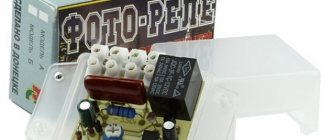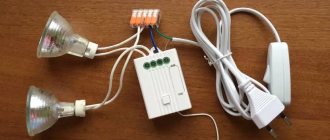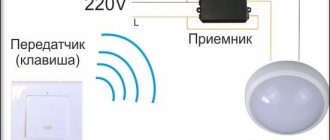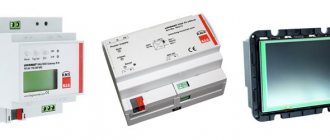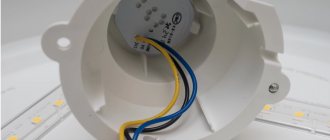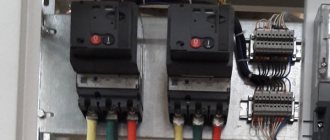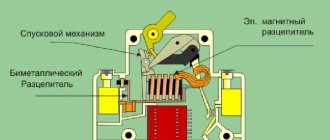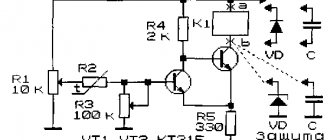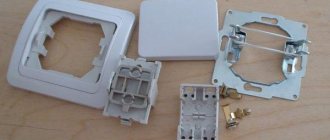04/27/201606/26/2016 master
Many people today use various technological devices in their homes and apartments that make home life easier to one degree or another. Especially often, such innovations are used in lighting systems in the entrance or in home areas. Today, one of the devices that are often connected to the lighting system are motion and volume sensors.
With the help of such devices, you can significantly increase the comfort of any room, gaining a lot of advantages. We will talk about what a volume sensor is and how to work with it in an apartment in this article.
What kind of sensor is this?
A volume sensor is a type of motion sensor. Such devices are also known in the world under the names radio wave, radar, and microwave sensors. With its help, you can organize automatic switching on and off of the light under certain specified conditions. Like motion sensors, these devices are used to independently turn on lights in various rooms. At the same time, the circuit and operating principles of these devices are practically indistinguishable from each other. Their installation offers several advantages:
Working device
- to turn on the light you just need to enter the room;
- no need to use switches;
- significant energy savings, since the light turns on only when it is needed;
- the light will turn on in the room, even if a child comes in. This is very useful, especially when children cannot reach the switch on their own. As a result, the risk of injury due to the lack of light in the room is significantly reduced;
- The device can be installed in any room of the house, even in the toilet.
Note! When installing volume sensors indoors (especially in the bathroom and toilet), you must take into account the features of the device sensors. Some of them can have a negative impact on human health.
Often such devices are used as components of a security system. Therefore, their installation is rational in entrances, garages, etc. Installing such devices in any room of the house (living room, bedroom, kitchen, toilet, bathroom, etc.) will not be so rational. Such a sensor will prove to be the most effective element of a security alarm in the corridor and rooms with spacious windows. Thanks to the precision of the settings, it can react to a violation of the integrity of the glass. Because of this, they are valued as elements of security systems. It is also worth noting that such devices, if desired, can be installed with your own hands. The main thing is to buy quality parts for assembly.
Lamp design features
The sensor interacts with any of the types of lamps on the market - incandescent, LED, and others. LED lamps with motion detectors are in greatest demand on the market.
In addition to the fact that they themselves provide energy savings, their compactness and ease of installation provide an advantage in competition with other lighting options.
Based on the method of using lamps, the following categories are distinguished:
- stationary, the installation of which requires the presence of a power supply network;
- portable, which operate on autonomous sources (batteries, solar and conventional batteries) and are not tied to an electrical outlet.
There are two options for connecting the sensor to the light source: remote and built-in. In a remote design, the detector and lamp are made in the form of separate elements, between which there is a wired connection. In another embodiment, the light bulb and the motion sensor are mounted in one housing.
Light bulbs with a sensitive motion sensor for the home and a similar street lamp differ in the degree of protection from external factors. Weather conditions in the form of rain, snow and other natural precipitation, temperature changes impose certain requirements on the design of a street lamp in terms of the degree of protection from dust and moisture ingress.
Models
Today there are several variations of volume sensors. They may differ from each other depending on the operating principle. Volume sensors for turning on/off lights are divided into the following types:
- ultrasonic models. To turn on the light, ultrasonic waves are used, reflected from objects located in the range of the device. Today, they are considered outdated devices, as they have a lot of disadvantages compared to more modern models. They are used very rarely and are found mainly as an element of external security alarms;
Ultrasonic modification
- microwave models. Here the operating principle is based on the sensor receiving microwave radiation. Cannot detect minor movements made by small insects or other objects while indoors. This type of device is characterized by poor sensitivity to assessing changes occurring in the controlled area of the device;
Note! They are quite dangerous models, but only if they are very close to humans or pets. Therefore, it is recommended to install them only outdoors. In home areas, especially in the toilet, bathroom and kitchen, such models can lead to deterioration in human health due to close and prolonged contact with microwave radiation.
Microwave sensor
Infrared model
- infrared devices. This type of device designed to turn on light is used most often, since compared to the models described above, they have practically no disadvantages and do not have a negative impact on the health of people when they are close or for a long time in the operating area of the device.
Note! Infrared volume sensors are today the most modern devices for turning on lights, functioning perfectly in a variety of conditions.
For rooms (living room, bedroom, kitchen, toilet and bathroom), the use of infrared volume sensors will be the most rational. But other models can give, in addition to their disadvantages, false lighting switches.
TOP best manufacturers in the domestic lighting market
This market segment has been firmly conquered by Chinese manufacturers, among which Feron and Mighty Light stand out. They were one of the first to present their products, which are distinguished by a powerful luminous flux.
High-quality lamps with motion sensors are offered by German manufacturers Steinel and Euroelectric. The first offers LED lamps with a motion sensor based on a sensor that perceives infrared radiation. The second specializes in outdoor options that operate in a wide temperature range. One of the best models for wall mounting is ST-69-2.
We recommend reading: how lighting of stair steps with a motion sensor can be implemented.
The Polish company Hardt supplies lamps with motion sensors protected from moisture and dust for the needs of housing and communal services; the Led-Hardt model would be an excellent choice.
Moscow and the regions of Russia are in the field of activity of numerous dealer centers and online stores, where fast delivery of any types of lamps with motion sensors will be ensured.
Principle of operation
As mentioned above, volume sensors have three main operating principles. Let's look at them in more detail:
- microwave sensor. A device of this kind emits a small amount of microwave radiation and immediately switches to receiving the signal. When the microwave radiation he emitted returns to him, he evaluates it. When it detects changes in the emitted signal, the sensor initiates activation of the lighting fixture connected to it and the light turns on. The device operates on the principle of a radar system. A diagram depicting the operating principle of this device is given below;
Note! Microwave and ultrasonic sensors work on the same principle. Only in the case of ultrasonic models, the device emits ultrasonic waves.
Microwave device - operating principle
- infrared devices have a slightly different operating principle. Here, the device perceives the nearby space as the field of a certain capacitor connected to an oscillating circuit with a high frequency. Any type of change in the capacity of the space limited by the operation of the device leads to disruption of generation or changes in the frequency range. As a result of this, the lamp is activated and the light turns on. Please be aware that certain atmospheric conditions or microwave oven activity may cause frequency changes. This must be taken into account when installing the device outdoors and especially at home.
As you can see, according to the principle of operation, volume sensors designed to automatically turn on lights are practically no different from devices that respond to movement.
Types of devices
Passive volumetric sensors
. The detector picks up heat from all objects and reacts to changes in its position. The movement is captured by a Fresnel lens consisting of several sectors. The sensor response speed is higher if the object crosses the segments in the perpendicular direction rather than in the longitudinal direction. This property is taken into account when choosing a location for installation.
Active volumetric sensors
. The devices themselves generate a signal and send it to the room. The waves are reflected from objects in the controlled area and returned to the receiver. The sensor controller calculates the reflection time of the radiation and uses it to determine moving objects. Active sensors work with ultrasound, therefore they are approved for use only in rooms where there are no people.
Device properties
Installation height
Any volume sensor that is used to turn on lighting in a room (in the kitchen, living room, toilet, etc.) has its own technical characteristics and can operate within a certain radius. And in order for it to work adequately, it must be properly configured. To ensure that the lights are turned on only when necessary, the following parameters should be taken into account:
- operating conditions of the device;
- optimal installation height;
- maximum range of action;
- permissible range for setting basic settings;
- diagram of connecting the device to the electrical network at home.
All parameters that are very important to consider when installing volume sensors are indicated by the manufacturer in the instructions, which should always be included with the device. If it is not there, you need to discuss this point with the seller.
Note! You should not indicate the maximum range of the device, as this can lead to its rapid breakdown. Here you should choose the optimal radius depending on your needs, the characteristics of the room itself and the brand of the device.
By following all the recommendations given in the instructions, you can not only install the sensors yourself without any problems, but also configure it correctly. When finely tuned, volume sensors have proven themselves to be excellent elements of security systems. If they are installed in the house, then even the quiet entry of unauthorized “guests” into the house will not go unnoticed. A break-in will be indicated by the lights turning on, as well as sound signals (if such an element is connected to the security system).
Installation principle
Placement
The effectiveness of volume sensors at home or on the street is largely determined by how correctly they were installed. There are strict rules here, which are always indicated in the instructions for the device.
Note! Installation rules are determined by the type of sensor and the operating principle of the device. Here you need to take into account the ability of ultrasonic, microwave and infrared radiation to penetrate different types of surfaces. If this is not done, the sensor will not work correctly.
The correct choice of the future location of the device is very important at this stage. In many situations, the optimal location for installing the device is a corner of a room or house. In this case, the operating radius of the device will be optimal. In addition, it is necessary to take into account the influence on the operation of the sensor of batteries, microwave ovens, air conditioners, fans, etc. Otherwise, the device may not operate correctly, which may result in false alarms.
Where can I buy
You can purchase smart lamps both in a specialized store and online in an online store. In the second case, the budget option for purchasing products on the AliExpress website deserves special attention. For some products there is an option for shipment from a warehouse in the Russian Federation; they can be received as quickly as possible; to do this, when ordering, select “Delivery from the Russian Federation”:
| Plutus-Quinn LED Night Light with Motion Sensor | LED ceiling lamps with motion sensor | Goodland LED Solar Light with Motion Sensor |
| Smart lamp KARWEN E27 with sound/passive IR motion sensor | LED night lights with motion sensor | Ceiling light, LED, with motion sensor |
Installation
Correct installation of the sensor to automatically turn on the lighting is simple and easy to do with your own hands. The installation diagram has the following algorithm:
- select installation location;
- turn off the electricity in the room or in the desired part of the house;
- study the connection diagram. It is always given in the instructions for the purchased model;
Connection diagram (example)
- Remove the back of the device and attach it to the wall. You need to connect strictly according to the instructions, the main thing is not to mix up the wires;
- if necessary, a switch should be connected to the switching circuit. It will allow you to adjust the light level manually.
When all the wires are connected, you can turn on the electricity. If you mess up or connect the wires incorrectly, you will hear a pop when the light turns on. This device has failed. There is nothing complicated about connecting a device to automatically turn on the light. Just follow the instructions, and the device will delight you with its efficient operation, and you will receive all the benefits of using a volume sensor.
Video: How to connect and test the FERON Sen 11 motion sensor
* * * * * * *
So, connecting a motion sensor to a spotlight or a regular lamp usually does not cause difficulties even for novice craftsmen. In addition, each manufacturer necessarily provides the buyer with instructions and a diagram for assembling the system, which simplifies the task even more. But when carrying out work, in addition to the recommendations of the instructions, all safety requirements must be observed. Electricity does not like and often does not forgive negligence, disregard for rules and other “jokes”. All electrical installation operations should be carried out only after the technician has ensured that the wiring in the work area is de-energized.
